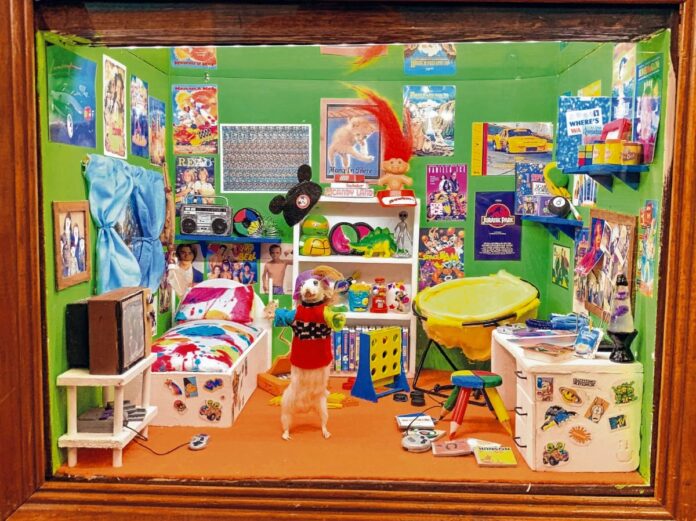
MACKINAW CITY — While meandering through the innumerable ostentatious gift establishments and t-shirt shacks of Mackinaw City, in a forever hunt for butterscotch fudge, a sign caught my eye: the Wacky Taxidermy and Miniatures Museum. My first thought was, “What sort of weird creepiness is this?” Now, mind, I’m always on the lookout for the unusual. In fact, I’ve taken some ribbing for my idea of a tourist attraction: the Spam Museum in Austin, Minnesota; the Devil’s Rope Museum in McLean, Texas; the Ropkey Armor Museum in Crawfordsville. For the paltry amount of $5 a ticket, the Wacky Taxidermy and Miniatures Museum seemed like a win. I rounded up my traveling companions, and in we went.
The first section of the two-room museum was dedicated to the history of taxidermy. Not surprisingly, the Egyptians were earliest known taxidermists, embalming cats (also not surprising), monkeys, birds, sheep and oxen for burial in the tomb of a pharaoh. The display included a photograph of the oldest known example of taxidermy: a crocodile which hangs from the ceiling of a church in Ponte Nossa, Italy, dates back to 1530.
We learned about John Scudder (1776-1821), a pioneer of American taxidermy whose business was absorbed by that greatest showman, P.T. Barnum. We see a photograph of a famous scene taxidermied (can that be a verb?) by Jules Verreaux. The photo features an Arab (made of wax and not taxidermied) riding on a camel that is being attacked by a lion. It was purchased in 1867 by the American Museum of Natural History but does not appear to be currently on display to the public.
No matter, because we have the entire Wacky Taxidermy and Miniatures Museum right here at our fingertips.
[sc:text-divider text-divider-title=”Story continues below gallery” ]
Our host and hostess for our visit were Julie and Brandon Howey, from — can you believe it — Anderson, Indiana. The two met in high school, and as their relationship developed, so did their obsession with taxidermy.
“It was a fascination with weird decoration,” said Julie Howey. “It fit our personalities. We went to antique stores and flea markets and bought up all the old taxidermy that nobody wanted anymore.”
But the two eventually ran out of places to shop and decided to create their own. Yes, they picked up their fair share of road kill, but they learned that deceased frozen mice could be purchased off the internet to feed carnivorous pets or zoo animals.
Howey felt it wasteful to purchase the frozen mice just for their skins, so they reached out to a nearby bird sanctuary to donate the remains of the mice as food for raptors and birds of prey.
“It’s very important to us,” Howey said. The cost of feeding the birds is $176 a day.
The second — and largest — room of the museum is whimsical fairyland of dioramas featuring mice — each one with a curled tail — in every manner of scenario possible. Is the beach your bailiwick? There are mice playing volleyball, surfing the curl and tanning (no pun intended) in the sun. The circus diorama features a ringmaster, acrobats and a squirrel posing as a lion. From the pages of literature comes the Mad Hatter’s tea party from “Alice in Wonderland,” featuring a small raccoon and a rabbit. And from the silver screen a Dr. Frankenstein squirrel reanimates a white mouse on his lab table.
Taxidermied animals are in every scenario, but the real stars of each scene are the hundred of detailed miniatures created especially for each diorama.
Howey admits her favorite is the 90s Kid’s Room.
“It’s a Nickelodeon Room,” Howey said. “It reminds me of being a kid in the 1990s.”
It’s not hard to pin a time period on the scene with posters on the wall from “Jurassic Park” and “Hook,” a beat box on a shelf above the bed, an Atari console under the television and a very tiny Connect Four game set up on the floor.
The museum, 272 S. Huron Ave., welcomes around 60 visitors a day and is open from May through October. At the end of the season, the couple — who have spent the summer in a pop-up trailer at a nearby campground — will return home to Anderson to their art studio to work on more dioramas and pieces the two can sell.
Naturally, visitors react differently to the exhibits.
“I love when people ask questions and they can look at it in a different way,” Howey said. “When we’re able to change people’s minds about taxidermy and bring people smiles.”



